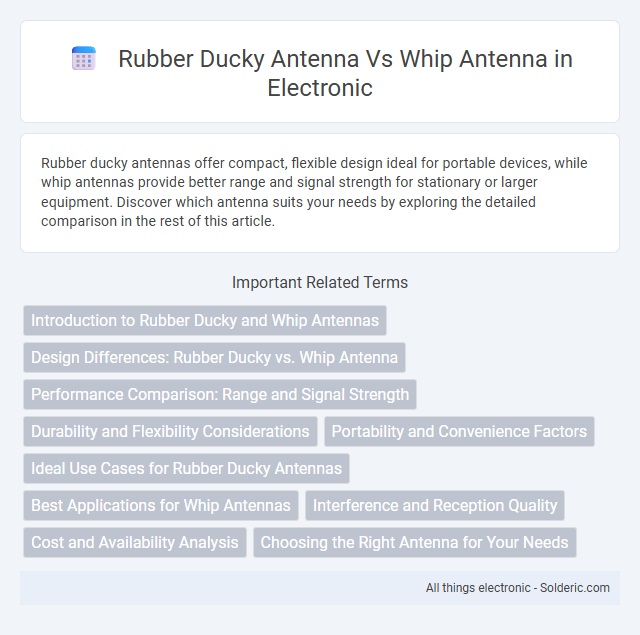Rubber ducky antennas offer compact, flexible design ideal for portable devices, while whip antennas provide better range and signal strength for stationary or larger equipment. Discover which antenna suits your needs by exploring the detailed comparison in the rest of this article.
Comparison Table
| Feature | Rubber Ducky Antenna | Whip Antenna |
|---|---|---|
| Length | Short, flexible (typically 6-8 inches) | Longer, rigid (typically 18-36 inches) |
| Durability | Highly flexible, resistant to bending damage | Rigid, prone to bending or breaking |
| Signal Performance | Moderate range, suitable for handheld devices | Better range and signal gain |
| Portability | Compact and easy to carry | Less compact, bulkier |
| Use Cases | Walkie-talkies, handheld radios, casual communication | Vehicle-mounted radios, base stations, extended range |
| Frequency Range | Generally designed for VHF/UHF bands | Wide frequency range based on length and design |
| Cost | Usually inexpensive | Varies, generally more expensive due to size |
Introduction to Rubber Ducky and Whip Antennas
Rubber ducky antennas are short, flexible antennas encased in a rubber sheath, commonly used in portable radios and handheld communication devices for their durability and compact design. Whip antennas consist of a straight, rigid metal rod that provides higher gain and better frequency performance, often found in vehicles and base stations due to their extended range capabilities. Both antenna types serve crucial roles in wireless communication, with rubber ducky antennas favoring portability and whip antennas prioritizing signal strength and range.
Design Differences: Rubber Ducky vs. Whip Antenna
Rubber ducky antennas feature a compact, flexible helical coil design that enhances durability and portability, making them ideal for handheld devices. Whip antennas consist of a straight, rigid metal rod that provides superior gain and signal range but is less convenient for mobile use. Your choice depends on balancing the need for robustness and convenience against maximum signal performance.
Performance Comparison: Range and Signal Strength
Rubber ducky antennas provide moderate range and signal strength due to their compact size and shortened design, making them ideal for portable devices but less effective for long-distance communication. Whip antennas, being longer and more efficient, offer superior range and stronger signal reception, which enhances overall performance in both transmitting and receiving signals. The choice between the two depends on the specific application, with whip antennas preferred for maximizing coverage and rubber ducky antennas chosen for convenience and portability.
Durability and Flexibility Considerations
Rubber ducky antennas offer enhanced durability due to their flexible rubber coating, which protects the internal coil from impacts and bending, making them ideal for portable and rugged use. Whip antennas, typically constructed from metal, provide less flexibility and can be prone to bending or breaking under stress, affecting their longevity in demanding environments. The rubber ducky's resilience to physical wear and ability to absorb shocks often results in a longer lifespan compared to the more rigid, fragile whip antenna designs.
Portability and Convenience Factors
Rubber ducky antennas offer superior portability due to their compact size and flexible design, making them ideal for handheld radios and mobile devices. Whip antennas, although generally longer and less flexible, provide better range but can be cumbersome to carry and use in tight spaces. For users prioritizing convenience and ease of transport, rubber ducky antennas deliver a practical balance between performance and portability.
Ideal Use Cases for Rubber Ducky Antennas
Rubber ducky antennas excel in portable and mobile applications where compact size and flexibility are critical, such as handheld radios, walkie-talkies, and vehicle-mounted communications. Their durable, insulated construction minimizes damage from impacts or bending, making them ideal for rugged outdoor environments and everyday carry. You benefit from consistent signal reception in close-range communication without the bulk or fragility of a whip antenna.
Best Applications for Whip Antennas
Whip antennas excel in applications requiring long-range communication and high gain, such as amateur radio, marine VHF, and emergency services. Their longer length compared to rubber ducky antennas provides better signal propagation and improved reception quality in outdoor or mobile environments. Whip antennas are ideal for vehicles, base stations, and outdoor setups where performance and durability are critical.
Interference and Reception Quality
Rubber ducky antennas typically exhibit higher resistance to interference due to their shorter length and flexible design, making them ideal for handheld devices operating in noisy environments. Whip antennas provide superior reception quality and range by leveraging their longer length to capture a broader spectrum of signals with less attenuation. The choice between these antennas depends on balancing the need for compactness and interference mitigation versus maximizing signal strength and clarity.
Cost and Availability Analysis
Rubber ducky antennas generally cost less and are widely available due to their simple construction and common use in handheld radios. Whip antennas tend to have a slightly higher price point, reflecting their better performance and durability in various communication devices. Both types are easily sourced from numerous electronics suppliers, but rubber ducky antennas are often preferred for budget-conscious buyers seeking reliable, low-cost options.
Choosing the Right Antenna for Your Needs
Choosing the right antenna depends on your specific use case and environment, with rubber ducky antennas offering compact, flexible designs ideal for portable devices or handheld radios, providing moderate range and durability. Whip antennas, being longer and more rigid, typically deliver better signal strength and range, making them suitable for vehicle-mounted or base station applications requiring enhanced performance. Assess your device compatibility, range requirements, and mobility preferences to ensure your antenna choice meets your communication needs effectively.
rubber ducky antenna vs whip antenna Infographic

 solderic.com
solderic.com